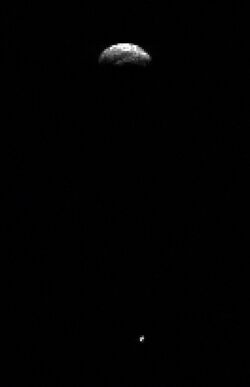Astronomy:2005 LW3
 Radar image of 2005 LW3 and its satellite (below) by the Goldstone Solar System Radar on 23 November 2022 | |
| Discovery[1][2] | |
|---|---|
| Discovered by | Siding Spring Survey |
| Discovery site | Siding Spring Obs. |
| Discovery date | 5 June 2005 |
| Designations | |
| 2005 LW3 | |
| Minor planet category | NEO · Apollo · PHA |
| Orbital characteristics[3] | |
| Epoch 25 February 2023 (JD 2460000.5) | |
| Uncertainty parameter 0 | |
| Observation arc | 17.49 yr (6,389 days)[1] |
| |{{{apsis}}}|helion}} | 2.106 AU |
| |{{{apsis}}}|helion}} | 0.771 AU |
| 1.439 AU | |
| Eccentricity | 0.4638 |
| Orbital period | 1.73 yr (630.3 days) |
| Mean anomaly | 81.385° |
| Mean motion | 0° 34m 16.171s / day |
| Inclination | 6.021° |
| Longitude of ascending node | 59.587° |
| |{{{apsis}}}|helion}} | 5 October 2022 |
| 288.663° | |
| Earth MOID | 0.001397 AU (209,000 km; 0.544 LD) |
| Jupiter MOID | 3.335 AU |
| Physical characteristics | |
| Mean diameter | 400 m (primary)[4] |
| Rotation period | 3.6 h[4] |
| Geometric albedo | 0.02[5] |
| Absolute magnitude (H) | 21.89[3] · 21.68[1] |
2005 LW3 is a binary near-Earth asteroid classified as a potentially hazardous object of the Apollo group. It was discovered on 5 June 2005 by the Siding Spring Survey at Siding Spring Observatory in Australia .[2] It made a close approach of 2.97 lunar distances (1.14×106 km; 0.71×106 mi) from Earth on 23 November 2022, reaching a peak brightness of apparent magnitude 13 as it passed over the northern celestial hemisphere sky.[1] It was extensively observed by astronomers worldwide during the close approach, and radar observations by NASA's Goldstone Solar System Radar in California discovered a 100 m (330 ft)-wide natural satellite orbiting the asteroid at a wide separation of 4 km (2.5 mi).[6][7]
Physical characteristics
Goldstone Solar System Radar observations in November 2022 resolved the shape of 2005 LW3, revealing a body 400 m (1,300 ft) in diameter—larger than its previously expected diameter of 150 m (490 ft).[4][7] For an absolute magnitude of 21.9, this radar-measured diameter indicates that 2005 LW3 has a very low geometric albedo of 0.02.[5] These radar observations also determined a rotation period of 3.6 hours for 2005 LW3.[4]
Satellite
The satellite of 2005 LW3 was discovered by a team of astronomers[lower-alpha 1] using Goldstone Solar System Radar observations from 23–27 November 2022. The satellite appears elongated, with equatorial dimensions of 100 m × 50 m (330 ft × 160 ft).[4] The satellite is widely separated from 2005 LW3 (the primary body of the system) at a semi-major axis of about 4 km (2.5 mi),[4] which is around 17% of the primary's Hill radius (24 km or 15 mi for an assumed primary density of 1.6 g/cm3).[5] The satellite's discovery was announced in a Central Bureau Electronic Telegram on 10 December 2022.[4]
Notes
References
- ↑ 1.0 1.1 1.2 1.3 "2005 LW3". Minor Planet Center. https://www.minorplanetcenter.net/db_search/show_object?object_id=2005+LW3. Retrieved 10 December 2022.
- ↑ 2.0 2.1 "MPEC 2005-L19 : 2005 LW3". Minor Planet Electronic Circular. Minor Planet Center. 6 June 2005. https://minorplanetcenter.net/mpec/K05/K05L19.html. Retrieved 10 December 2022.
- ↑ 3.0 3.1 "JPL Small-Body Database Browser: (2005 LW3)". Jet Propulsion Laboratory. https://ssd.jpl.nasa.gov/tools/sbdb_lookup.html#/?sstr=3279432. Retrieved 10 December 2022.
- ↑ 4.0 4.1 4.2 4.3 4.4 4.5 4.6 4.7 Green, Daniel W. E. (10 December 2022). "CBET 5198: 2005 LW_3". Central Bureau Electronic Telegram. Central Bureau for astronomical Telegrams. http://www.cbat.eps.harvard.edu/iau/cbet/005100/CBET005198.txt. Retrieved 10 December 2022.
- ↑ 5.0 5.1 5.2 Johnston, Wm. Robert (1 December 2022). "2005 LW3". Johnston's Archive. http://www.johnstonsarchive.net/astro/astmoons/am2005lw3.html. Retrieved 10 December 2022.
- ↑ "MPEC 2022-U222 : International Asteroid Warning Network (IAWN) Timing Campaign". Minor Planet Electronic Circular. Minor Planet Center. 24 October 2022. https://minorplanetcenter.net/mpec/K22/K22UM2.html. Retrieved 10 December 2022.
- ↑ 7.0 7.1 Benner, Lance A. M. (10 December 2022). "Goldstone Radar Observations Planning: 2005 LW3, 1998 SS49, and 2017 QL33". NASA. https://echo.jpl.nasa.gov/asteroids/2005LW3/2005LW3.2022.goldstone.planning.html. Retrieved 10 December 2022.
External links
- 2005 LW3: Timing Assessment, International Asteroid Warning Network, last updated 29 November 2022
- Asteroid 2005 LW3 Campaign: Timing is Everything!, Leonard David, 5 November 2022
- 2005 LW3 at NeoDyS-2, Near Earth Objects—Dynamic Site
- Ephemeris · Obs prediction · Orbital info · MOID · Proper elements · Obs info · Close · Physical info · NEOCC
- 2005 LW3 at ESA–space situational awareness
- 2005 LW3 at the JPL Small-Body Database
 |

